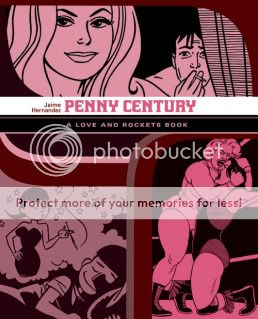Penny Century
Love and Rockets Library: Locas, Book Four
Jaime Hernandez, writer/artist
Fantagraphics, 2010
240 pages
$18.99
Grown-ups! More or less. This volume collects stories that follow the conclusion of Love and Rockets Volume One, the initial years-long run of the series’ comic-book format–first in spinoffs and standalones, then in L&R Volume 2–and it’s clear Jaime took the dividing line seriously. From the largely wordless wrestling action of “Whoa, Nellie!” to the less spotted-black-driven line art of the “Maggie & Hopey Color Fun” (here presented in glorious black and white), the comics in Penny Century look less dense and read that way, too. Maggie and Hopey seem to have settled down, somewhat–no longer careening from adventure to adventure or disaster to disaster, still involved in the lives and schemes of their eccentric friends but no longer completely swept up by them, still romantically (or at least sexually) entangled with one another but not to the all-or-nothing extremes of the past. The most frantic strips in the collection, “Chiller!” and “The Race,” are a late-night driving-alone mind-playing-tricks-on-Mag freakout and an out-and-out dream sequence respectively. The horns on H.R. Costigan’s noggin, heretofore the Locas strips’ only remaining visual link with their sci-fi roots, are explained away. The most outlandish thing that happens here, Izzy’s magic-realist transformation into a giant, is tied to her very adult concern about an upcoming reading from her recently published memoir, and the comic’s last remaining great free spirit, Penny Century, spends most of the book hiding from attention and is then widowed. Even the “who’s who” portrait page at the back of the book has been cut. The wild-oats-sowing crises of the sort that drove “Wigwam Bam” and “Chester Square” are over. The Locas have matured.
Ironically, perhaps, Jaime takes this opportunity to indulge himself, if not his characters. He transforms Ray D. into a sort of hard-boiled hard-luck case, whose first-person narration captions speak of falling in with femme fatale Penny and cruising for action like the least violent installment of Sin City ever. He tells his longest li’ Locas story yet in “Home School,” which reveals the origin of Izzy’s undying affection for Maggie in a fashion that’s adorable–and carefully observed–as young Maggie’s plight is revealed to be heartbreaking. He has Penny avoid the impending circus her life is about to become by also avoiding clothing. He draws page after page after glorious, please-study-this,-Avengers-artists page of women’s wrestling action, an absolute master class in conveying the physical consequences of bodies in motion and collision.
And in the collection’s gutsiest, flashiest move, he turns one of his long-running storytelling innovations into ostentation by completely eliding Maggie’s entire marriage until we learn of her divorce. Obviously, the Locas stories are full of events we only find out about after the fact–from Esther’s forced haircut to Ray and Penny’s affair–but usually the characters involved were off-screen at the time. Maggie, on the other hand, remains our main character for the bulk of this book, so finding out she married a dude during that time comes as a shock. It’s kind of gratuitous, even–it’s Jaime doing the Jaime-est thing he could possibly do with his signature character. Why? Why not? That ends up being a sufficient answer. Sure, we go along with it in the end in large part because the flashback history we discover between Maggie and Top Cat Tony is convincing, and because Locas has always been about the past’s bizarre on-again off-again romance with the present. But mostly we go along with it because it’s fun, because Jaime has earned the right to even the most spectacular stylistic flourishes–sort of how Tony’s okay with Maggie’s dalliances with Hopey, since, well, that’s Maggie. Settling down often just means owning your weirdness.
Tags: comics, comics reviews, Comics Time, Jaime Hernandez, Los Bros Hernandez, Love and Rockets, LOVE AND ROCKTOBER, reviews


I remember reading those issues where Maggie got married for the first time and feeling shocked by the way it was casually unveiled, followed by delight that Jaime could still provoke a reaction like that.
That storytelling swerve fits in with a couple of things you touched on earlier, Sean. Firstly, it reinforced the sense that these are real people who have real lives, most of which happens outside the comic panel. Love & Rockets has always been a comic where characters could disappear for years — even decades — and Maggie was never an exception to this. To hear of her marriage third-hand was nothing new.
These kinds of natural gaps also ensured there was plenty of room to retroactively insert her new husband as another part of Maggie’s weird and sprawling life, and I have to admit getting a kick out of the fact that he was the only person there when Maggie injured her ankle — an injury that played an occasionally crucial plot point in the series.
It also went back to the idea that while Maggie and/or Hopey might appear to be the perfect girlfriend/wife/partner/whatever, they were actually really difficult people to get close to, and could inadvertently harm the people who do manage to get inside their world. They’re not perfect, and while none of us are, the Locas girls can also be dangerous without even trying.
This whole period of Jaime’s was one where the characters really started feeling their age, and I honestly feel it kicked off the best period of his comics – one that is still going strong now – where age and memory and the weirdness of proper adulthood has created a richer and more powerful comic.